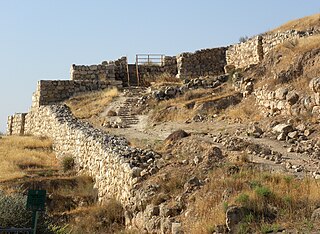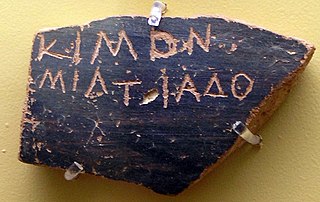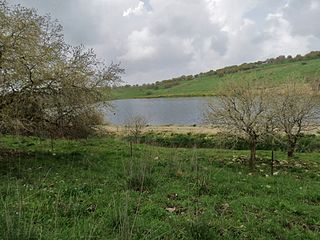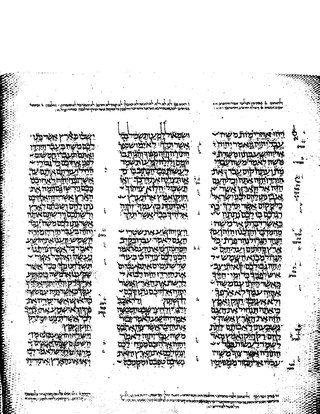The Book of Kings is a book in the Hebrew Bible, found as two books in the Old Testament of the Christian Bible. It concludes the Deuteronomistic history, a history of ancient Israel also including the books of Joshua, Judges, and Samuel.

Jehu was the tenth king of the northern Kingdom of Israel since Jeroboam I, noted for exterminating the house of Ahab. He was the son of Jehoshaphat, grandson of Nimshi, and possibly great-grandson of Omri, although the latter notion is not supported by the biblical text. His reign lasted 28 years.

The Kingdom of Israel, or the Kingdom of Samaria, was an Israelite kingdom in the Southern Levant during the Iron Age, whose beginnings can be dated back to the first half of the 10th century BCE. The kingdom controlled the areas of Samaria, Galilee and parts of Transjordan. The regions of Samaria and Galilee underwent a period with large number of settlements during the 10th century BCE, with the capital in Shechem, and then in Tirzah. The kingdom was ruled by the Omride dynasty in the 9th century BCE, whose political center was the city of Samaria.

Samaria is the Hellenized form of the Hebrew name Shomron, used as a historical and biblical name for the central region of Israel, bordered by Judea to the south and Galilee to the north. The region is known to the Palestinians in Arabic under two names, Samirah, and Mount Nablus.

Lachish was an ancient Canaanite and Israelite city in the Shephelah region of Israel, on the south bank of the Lakhish River, mentioned several times in the Hebrew Bible. The current tell (ruin) by that name, known as Tel Lachish or Tell ed-Duweir, has been identified with the biblical Lachish. Today, it is an Israeli national park operated and maintained by the Israel Nature and Parks Authority. It lies near the present-day moshav of Lakhish.

An ostracon is a piece of pottery, usually broken off from a vase or other earthenware vessel. In an archaeological or epigraphical context, ostraca refer to sherds or even small pieces of stone that have writing scratched into them. Usually these are considered to have been broken off before the writing was added; ancient people used the cheap, plentiful, and durable broken pieces of pottery around them as a convenient medium to write on for a wide variety of purposes, mostly very short inscriptions, but in some cases very long.

Tel Arad, in Arabic Tell 'Arad, is an archaeological tell, or mound, located west of the Dead Sea, about 10 kilometres west of the modern Israeli city of Arad in an area surrounded by mountain ridges which is known as the Arad Plain. The Tel overlooks an important crossroads from the Early Bronze Age to the present day. During the Iron Age, Arad defended the main road that went from Jerusalem, Hebron, the Arad Valley towards the ruins of Horvat Uza and the Dead Sea.
According to the Hebrew Bible, the Abiezrites were one of the ten clans identified as belonging to the tribe of Manasseh. The Abiezrites traced their lineage through Abiezer, the son of Gilead. Joash and Gideon were members of this clan: Gideon describes the Abiezrites, as "the weakest in [the tribe of] Manasseh". The Samaria Ostraca, written between 850-750 BCE, records two villages associated with the Abiezrites. Scholars have identified that the clan lived in the area south and southwest of Shechem.
Baʿal Berith and El Berith are titles of a god or gods worshiped in Shechem, in ancient Canaan, according to the Bible.
Sanballat the Horonite – or Sanballat I – was a Samaritan leader, official of the Achaemenid Empire, and contemporary of the Israelite prophet Nehemiah who lived in the mid-to-late 5th century BC. He and his family are mentioned in the contemporary Elephantine papyri and ostraca.

Sebastia is a Palestinian village of about 3,205 inhabitants, located in the Nablus Governorate of the State of Palestine, some 12 kilometers northwest of the city of Nablus.

Yasid is a Palestinian town in the Nablus Governorate in northern West Bank, located 15 kilometers northeast of Nablus. According to the Palestinian Central Bureau of Statistics (PCBS), the town had a population of 2,291 inhabitants in mid-year 2006 and 2,505 by 2017.

The Manasseh Hills or hill country of Manasseh, directly derived from Hebrew: Menashe Heights, called Bilad ar-Ruha in Arabic, meaning "Land of Winds", is a geographical region in northern Israel, located on the Carmel Range, between Mount Carmel and Mount Amir/Umm al-Fahm.

Samaria was the capital city of the Kingdom of Israel between c. 880 BCE and c. 720 BCE. It is the namesake of Samaria, a historical region bounded by Judea to the south and by Galilee to the north. After the Assyrian conquest of Israel, Samaria was annexed by the Neo-Assyrian Empire and continued as an administrative centre. It retained this status in the Neo-Babylonian Empire and the Achaemenid Persian Empire before being destroyed during the Wars of Alexander the Great. Later, under the hegemony of the Roman Republic and the subsequent Roman Empire, the city was rebuilt and expanded by the Jewish king Herod the Great, who also fortified it and renamed it "Sebastia" in honour of the Roman emperor Augustus.
The Ophel pithos is a 3,000-year-old inscription on a fragment of a ceramic jar found near Jerusalem's Temple Mount by Israeli archeologist Eilat Mazar.

2 Kings 22 is the twenty-second chapter of the second part of the Books of Kings in the Hebrew Bible or the Second Book of Kings in the Old Testament of the Christian Bible. The book is a compilation of various annals recording the acts of the kings of Israel and Judah by a Deuteronomic compiler in the seventh century BCE, with a supplement added in the sixth century BCE. This chapter records the events during the reign of Josiah, the king of Judah, especially the discovery of the Book of the Law (Torah) during the renovation of the Temple in Jerusalem.

The Arad ostraca, also known as the Eliashib Archive, is a collection of more than 200 inscribed pottery shards found at Tel Arad in the 1960s by archeologist Yohanan Aharoni. Arad was an Iron Age fort at the southern outskirts of the Kingdom of Judah, close to Beersheba in modern Israel.

The Tel Qasile ostraca are two small ostraca found at Tell Qasile, then part of Mandatory Palestine, in 1945–46. The longer of the two ostraca is known as the Beth-horon sherd, on the basis of a possible reference to the biblical site of Bethoron. The Beth-horon sherd is now at the Israel Museum in Jerusalem.

Joshua 17 is the seventeenth chapter of the Book of Joshua in the Hebrew Bible or in the Old Testament of the Christian Bible. According to Jewish tradition the book was attributed to the Joshua, with additions by the high priests Eleazar and Phinehas, but modern scholars view it as part of the Deuteronomistic History, which spans the books of Deuteronomy to 2 Kings, attributed to nationalistic and devotedly Yahwistic writers during the time of the reformer Judean king Josiah in 7th century BCE. This chapter records the allotment of land for the tribe of Joseph, especially the tribe of Manasseh, a part of a section comprising Joshua 13:1–21:45 about the Israelites allotting the land of Canaan.















